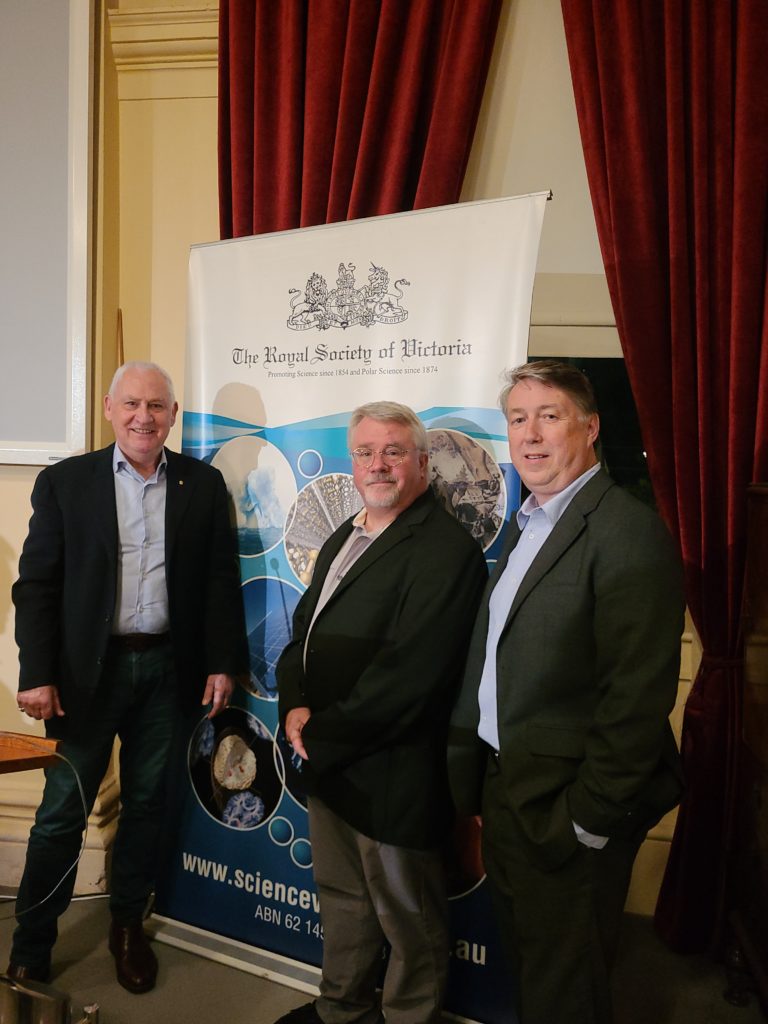Reinventing the Chemical Industry with Green Chemistry
By Dr Catriona Nguyen-Robertson MRSV
Senior Editor, Science Victoria
The following article follows a presentation to the Royal Society of Victoria and the ARC Training Centre for Green Chemistry in Manufacturing delivered by Dr Paul Anastas (Yale University) and Dr John Warner (Monash University) in July 2023.
Science isn’t always the most sustainable of endeavours.
Resource consumption, waste generation, and high energy demands contribute to the large environmental impact of laboratories and research facilities. Biological, medical, and agricultural research alone are estimated to produce 5.5 million tons of plastic waste in a year.1 Laboratories also can use five to ten times more water and energy per square foot than office spaces.2
However, Dr Paul Anastas and Dr John Warner argue that it is both possible and vital to build a global culture of sustainability in science.
‘We humans are the product of evolution – we are as much a part of nature as anything else. That puts us in the wrong place when we start to think of ourselves as outside of nature…We can’t have no impact, but we should be mindful of what our impact is,’ says John.
The building blocks of green chemistry
John and Paul have been developing ways to reduce the environmental impact of chemistry for decades, and encouraging others to do the same. Green chemistry emerged from a variety of existing ideas and research efforts in the period leading up to the 1990s, culminating in twelve principles of green chemistry outlined by Paul and John in 1998.3
These principles encourage the design of products and processes that are more resource-efficient, and minimise or eliminate the use and generation of hazardous substances. With increasing attention around the problems of chemical pollution and nonrenewable resource depletion, these principles propose environmentally favourable ways of product design – from appropriate choice of reagents for synthesis to the waste at the end of a material’s life.
‘Everything we see, touch, and feel is chemistry,’ says Paul. ‘Green chemistry is about how you use these principles to redesign the material basis of our society and economy.’
When conducting chemistry, it can be easy to focus on your specific role within a larger picture. John encourages people to take a step back and think about the whole material ecosystem.
We use natural resources to make molecules and ingredients that are then used to synthesise materials and components. From those, we manufacture products – ideally, those products can be reused for a long period of time. But when products eventually break down, we ideally will recycle the materials and components, and if needed, revert those back to the molecules and ingredients to be used again.
John defines this as “materials metabolism”. If we consider the individual components of the “metabolism” reactions as we move between ingredients, materials, and products, we can learn to be more sustainable at each step.
Not just a marketing bumper sticker
Green chemistry is not just about validating marketing claims if a product’s synthesis is aligned with the twelve principles. It is about rethinking the way we do things – both in the lab and in wider society.
John is a prolific inventor, with over 300 patents in a range of industries, and using green chemistry as the foundation for them all. A product close to John’s heart – or head – is Hairprint, which restores grey hair to its original colour (he has even used it himself, having gone grey at an early age). His inspiration for Hairprint was a beetle – as it grows, its exoskeleton begins as white, before becoming black within hours. The black colour is due to melanin, the same pigment responsible for our hair colour. John wondered whether he could use a precursor to melanin, a compound called L-DOPA, to achieve this same colouring.
It turns out he could – and the hair isn’t simply painted black with L-DOPA, it reverts grey hair to its original colour. When experimenting with a bundle of grey human hair, John discovered that strands of hair from different people turned various shades of brown and black.

L-DOPA is the key component of Hairprint, and John uses the tropical plant Mucuna pruriens (velvet beans) as a natural source of the compound. His other inventions include an asphalt rejuvenator that allows old bitumen to be re-used when the asphalt wears and needs to be replaced, and pharmaceutical therapies for the nervous system disease, ALS.
“Benign by design,” green chemistry revolves around making materials with sustainability built-in. There are still Research and Development (R&D) scientists who do not put sustainability and green chemistry metrics into their science. It’s an add-on or after-thought – if that. For years, we have been trying to make processes more efficient (e.g., diesel consumption, fuel use, etc.) as a society, but, as Paul says, ‘efficiency helps you do the thing better, but won’t help you do a better thing.’
The question isn’t whether we can come up with sustainable solutions to planetary solutions. As Paul points out: we can, and we have. But will we?
The invention barrier
Among all the chemical products and processes that exist, John believes that only 10% tick every box to be truly sustainable. Even if we wanted to flick a switch and create every product using green chemistry principles from now on, he believes that it would not be possible. ‘This is not a crisis of desire, but ability…60-75% of the technologies [we need] have not been invented yet,’ he says.
While you can receive a degree in chemistry from universities around the world, we lack a workforce that understands how to invent products and methods that are truly sustainable. Universities do not necessarily teach chemists how to anticipate the health and environmental impacts of their processes. To address this, John and his former student Dr Amy Cannon, who holds the world’s first PhD in the field of green chemistry, co-founded the Beyond Benign program to provide educators with resources to integrate green chemistry into chemistry education.4
In particular, their ‘Green Chemistry Commitment’ campaign encourages higher education institutions to incorporate green chemistry into their curricula. Around the world, 120 universities have now committed, with Monash University being the first in the southern hemisphere. If we teach the next generation of chemists to be green chemists, they will come up with new ideas and invent ways of doing chemistry that support a sustainable future.
Meanwhile, one of Paul’s many projects is the Molecular Design Research Network (MoDRN), an initiative that aims to reduce the toxicity of new chemical substances.5 ‘We’ve been able to design molecules that have all kinds of functionality,’ he says. ‘But we’re not so good at designing things to be non-toxic’. In the same way that chemists can predict what makes a molecule dissolve in water, or melt at a low temperature, he wants to encourage them to predict how these molecules interact with us and the environment before they are made.

Advances in chemistry and ecological engineering research have adopted sustainable practices over the years. Continuing to invest in sustainable industrial techniques and policies will be extremely important in improving the environment and our relationship with it. One of John and Paul’s goals with green chemistry is for the term to completely disappear – it should ideally simply become how we practise chemistry and make things.
You can watch John and Paul’s presentation in full at youtu.be/wgGNhqR8zR0 (or in brief at youtu.be/hjnBccq5N8g).
References:
- Urbina, M., Watts, A. & Reardon, E. (2015). Labs should cut plastic waste too. Nature, 528, 479. doi.org/10.1038/528479c
- U.S. Environmental Protection Agency. (2008, August). Laboratories for the 21st Century: An Introduction to Low-Energy Design. nrel.gov/docs/fy08osti/29413.pdf
- Anastas, P. T. and Warner, J. C. (1998). Green Chemistry: Theory and Practice. Oxford University Press: New York, p. 30.
- Beyond Benign | Green Chemistry Education. beyondbenign.org
- Molecular Design Research Network (MoDRN). modrn.yale.edu








